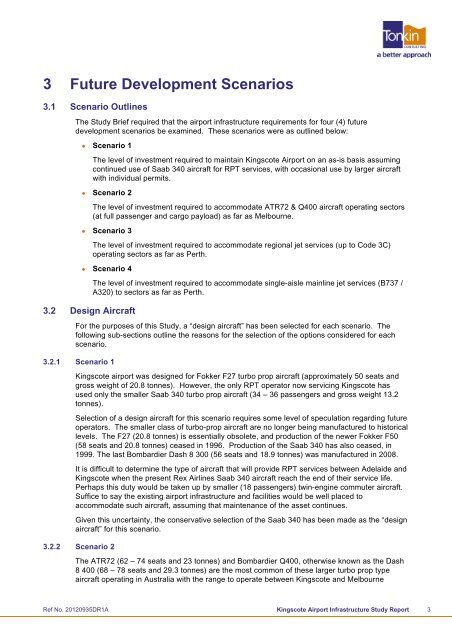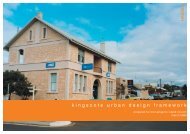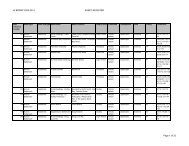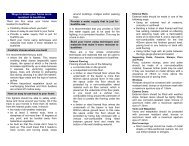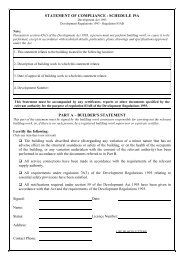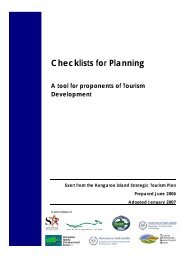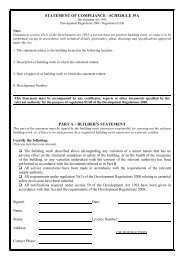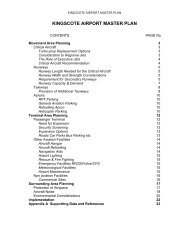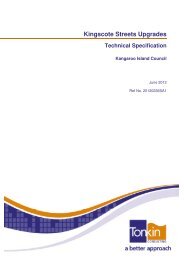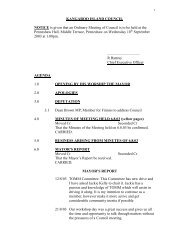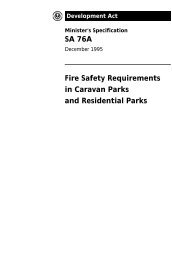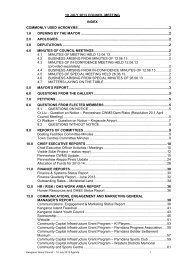Kingscote Airport Business Case Appendices - Kangaroo Island ...
Kingscote Airport Business Case Appendices - Kangaroo Island ...
Kingscote Airport Business Case Appendices - Kangaroo Island ...
- No tags were found...
You also want an ePaper? Increase the reach of your titles
YUMPU automatically turns print PDFs into web optimized ePapers that Google loves.
3 Future Development Scenarios3.1 Scenario OutlinesThe Study Brief required that the airport infrastructure requirements for four (4) futuredevelopment scenarios be examined. These scenarios were as outlined below: Scenario 1The level of investment required to maintain <strong>Kingscote</strong> <strong>Airport</strong> on an as-is basis assumingcontinued use of Saab 340 aircraft for RPT services, with occasional use by larger aircraftwith individual permits. Scenario 2The level of investment required to accommodate ATR72 & Q400 aircraft operating sectors(at full passenger and cargo payload) as far as Melbourne. Scenario 3The level of investment required to accommodate regional jet services (up to Code 3C)operating sectors as far as Perth. Scenario 43.2 Design AircraftThe level of investment required to accommodate single-aisle mainline jet services (B737 /A320) to sectors as far as Perth.For the purposes of this Study, a “design aircraft” has been selected for each scenario. Thefollowing sub-sections outline the reasons for the selection of the options considered for eachscenario.3.2.1 Scenario 1<strong>Kingscote</strong> airport was designed for Fokker F27 turbo prop aircraft (approximately 50 seats andgross weight of 20.8 tonnes). However, the only RPT operator now servicing <strong>Kingscote</strong> hasused only the smaller Saab 340 turbo prop aircraft (34 – 36 passengers and gross weight 13.2tonnes).Selection of a design aircraft for this scenario requires some level of speculation regarding futureoperators. The smaller class of turbo-prop aircraft are no longer being manufactured to historicallevels. The F27 (20.8 tonnes) is essentially obsolete, and production of the newer Fokker F50(58 seats and 20.8 tonnes) ceased in 1996. Production of the Saab 340 has also ceased, in1999. The last Bombardier Dash 8 300 (56 seats and 18.9 tonnes) was manufactured in 2008.It is difficult to determine the type of aircraft that will provide RPT services between Adelaide and<strong>Kingscote</strong> when the present Rex Airlines Saab 340 aircraft reach the end of their service life.Perhaps this duty would be taken up by smaller (18 passengers) twin-engine commuter aircraft.Suffice to say the existing airport infrastructure and facilities would be well placed toaccommodate such aircraft, assuming that maintenance of the asset continues.Given this uncertainty, the conservative selection of the Saab 340 has been made as the “designaircraft” for this scenario.3.2.2 Scenario 2The ATR72 (62 – 74 seats and 23 tonnes) and Bombardier Q400, otherwise known as the Dash8 400 (68 – 78 seats and 29.3 tonnes) are the most common of these larger turbo prop typeaircraft operating in Australia with the range to operate between <strong>Kingscote</strong> and MelbourneRef No. 20120935DR1A <strong>Kingscote</strong> <strong>Airport</strong> Infrastructure Study Report 3


